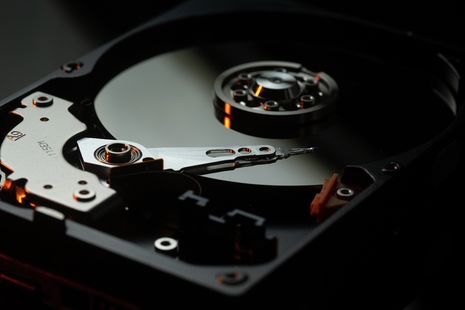Creating better hard disk drives with graphene
In this Cambridge Spotlight, Izavel Lee explains new research from the Cambridge Graphene Centre on ultra-high storage density hard disk drives

Graphene, previously described as a “wonder material”, has now found a new application — as a component of hard disk drives (HDDs). In a study published in Nature Communications last week, researchers from the Cambridge Graphene Centre, along with an international group of scientists from the University of Exeter, Singapore, Switzerland, India and the US, have found that graphene can be used in conjunction with other HDD technologies to create ultra-high storage density HDDs. According to Professor Andrea C. Ferrari, Director of the Cambridge Graphene Centre, the work “indicate[s] a route for mass application of graphene in cutting-edge technologies”.
HDDs are a type of data storage device first invented in the 1950s. Although the laptop or smartphone that you are using most likely has a solid state drive (SSD), HDDs are still widely used in datacenters and some desktops as they have a lower cost per gigabyte and have much higher storage capacity. Current SSD production is also simply insufficient to keep up with the current rate of data being generated. However, SSDs remain a real threat to the future production of HDDs, so researchers have been looking for ways to make HDDs more compact. This would improve the amount of data that can be stored per unit area of HDD (i.e., storage density).
“The graphene overcoats outperformed commercial overcoats in every criterion that the researchers tested”
One of the main approaches is to reduce the space between the head and the hard disk medium. The head is the part of the hard drive which writes data from the computer onto the hard disk medium or reads data from the medium to the computer. These hard disk mediums are typically protected from mechanical damage and corrosion by a carbon-based overcoat, which take up a lot of space in the hard disk. Current commercial overcoats have a thickness of about 2.5-3nm. This may not sound like a lot, but a reduction of thickness from 12.5nm to 3nm can lead to an increase of 1 terabyte per square inch of HDD. That’s more storage than most mainstream laptops contain! As such, making thinner overcoats that are equally damage and corrosion resistant would greatly help the compactness of HDDs.
As it turns out, graphene may be especially suited for making such ultra-thin overcoats. Although a coat of graphene consists of just a single layer of carbon atoms, it is very strong and flexible, with low friction and high resistance to corrosion — exactly the characteristics of an ideal overcoat. Graphene is currently being researched for applications in batteries, fuel cells, solar panels, and even drug delivery.
In the study, the researchers synthesized graphene using a method known as chemical vapor deposition. They then coated two different types of hard disk mediums with 1-4 layers of graphene. One of these hard disk mediums was made from a cobalt alloy, and the other was made of iron-platinum. With the iron-platinum hard disk, the team also tested a recent technology known as heat assisted magnetic recording (HAMR), which increases the storage capability of the hard disk but also tends to overheat commercial carbon overcoats.
As expected, the graphene overcoats were much thinner than commercial ones, with even the 4-layer graphene overcoat measuring only 2.1nm thick. Moreover, the graphene overcoats outperformed commercial overcoats in every criterion that the researchers tested. Graphene had higher thermal stability when irradiated with a laser, which would make it useful as an overcoat in HAMR hard disks. The graphene overcoats also lowered friction by two-fold compared to commercial overcoats, and were better at protecting the hard disk mediums from corrosion too. By combining graphene overcoats with HAMR technology, the researchers predicted that HDDs could store more than 10 terabytes per square inch, way beyond the current record holder of 1.3 terabytes per square inch.
Trillions of gigabytes are being generated every year, and this number is expected to increase rapidly each day. Ultra-high storage density HDDs, potentially with graphene overcoats, will likely play a critical role in the future of data storage. “Demonstrating that graphene can serve as protective coating for conventional hard disk drives and that it is able to withstand HAMR conditions is a very important result. This will further push the development of novel high areal density hard disk drives,” reported Dr Anna Ott from the Cambridge Graphene Centre.
 News / Cambridge study finds students learn better with notes than AI13 December 2025
News / Cambridge study finds students learn better with notes than AI13 December 2025 Features / Should I stay or should I go? Cambridge students and alumni reflect on how their memories stay with them15 December 2025
Features / Should I stay or should I go? Cambridge students and alumni reflect on how their memories stay with them15 December 2025 News / Uni Scout and Guide Club affirms trans inclusion 12 December 2025
News / Uni Scout and Guide Club affirms trans inclusion 12 December 2025 Comment / The magic of an eight-week term15 December 2025
Comment / The magic of an eight-week term15 December 2025 News / Cambridge Vet School gets lifeline year to stay accredited28 November 2025
News / Cambridge Vet School gets lifeline year to stay accredited28 November 2025









